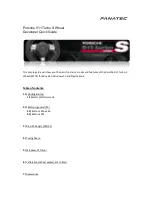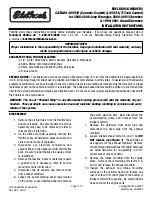
SERVICING AND MAINTENANCE
261
The radiator normally remains completely full, so
there is no need to remove the radiator cap unless
checking for engine coolant (antifreeze) freeze
point or replacing engine coolant (antifreeze).
Advise your service attendant of this. As long as the
engine operating temperature is satisfactory, the
coolant bottle need only be checked once a month.
When additional engine coolant (antifreeze) is
needed to maintain the proper level, it should be
added to the coolant bottle. Do not overfill.
Points To Remember
NOTE:
When the vehicle is stopped after a few miles/kilo
-
meters of operation, you may observe vapor coming
from the front of the engine compartment. This is
normally a result of moisture from rain, snow, or high
humidity accumulating on the radiator and being
vaporized when the thermostat opens, allowing hot
engine coolant (antifreeze) to enter the radiator.
If an examination of your engine compartment
shows no evidence of radiator or hose leaks, the
vehicle may be safely driven. The vapor will soon
dissipate.
Do not overfill the coolant expansion bottle.
Check the coolant freeze point in the radiator
and in the coolant expansion bottle. If engine
coolant (antifreeze) needs to be added, the
contents of the coolant expansion bottle must
also be protected against freezing.
If frequent engine coolant (antifreeze) additions
are required, the cooling system should be pres
-
sure tested for leaks.
Maintain engine coolant (antifreeze) concentra
-
tion at a minimum of 50% OAT coolant
(conforming to MS.90032) and distilled water
for proper corrosion protection of your engine
which contains aluminum components.
Make sure that the coolant expansion bottle
overflow hoses are not kinked or obstructed.
Keep the front of the radiator clean. If your
vehicle is equipped with air conditioning, keep
the front of the condenser clean.
Do not change the thermostat for Summer or
Winter operation. If replacement is ever neces
-
sary, install ONLY the correct type thermostat.
Other designs may result in unsatisfactory
engine coolant (antifreeze) performance, poor
gas mileage, and increased emissions.
B
RAKE
S
YSTEM
In order to ensure brake system performance, all
brake system components should be inspected
periodically. Refer to the “Maintenance Plan” in
this chapter for the proper maintenance intervals.
Fluid Level Check — Brake Master Cylinder
The fluid level of the master cylinder should be
checked when performing under the hood service
or immediately if the brake system warning lamp
indicates system failure.
The brake master cylinder has a translucent plastic
reservoir. On the outboard side of the reservoir,
there is a “MAX” mark and a “MIN” mark. The fluid
level must be kept within these two marks. Do not
add fluid above the MAX mark because leakage
may occur at the cap.
With disc brakes the fluid level can be expected to
fall as the brake linings wear. However, an
unexpected drop in fluid level may be caused by a
leak and a system check should be conducted.
Refer to “Fluids And Lubricants” in “Technical
Specifications” for further information.
WARNING!
Riding the brakes can lead to brake failure and
possibly a collision. Driving with your foot resting
or riding on the brake pedal can result in
abnormally high brake temperatures, excessive
lining wear, and possible brake damage. You
would not have your full braking capacity in an
emergency.
7
20_DS_OM_EN_USC_t.book Page 261
















































